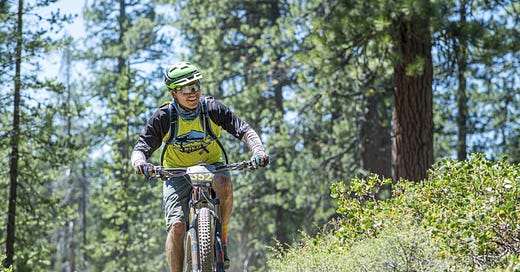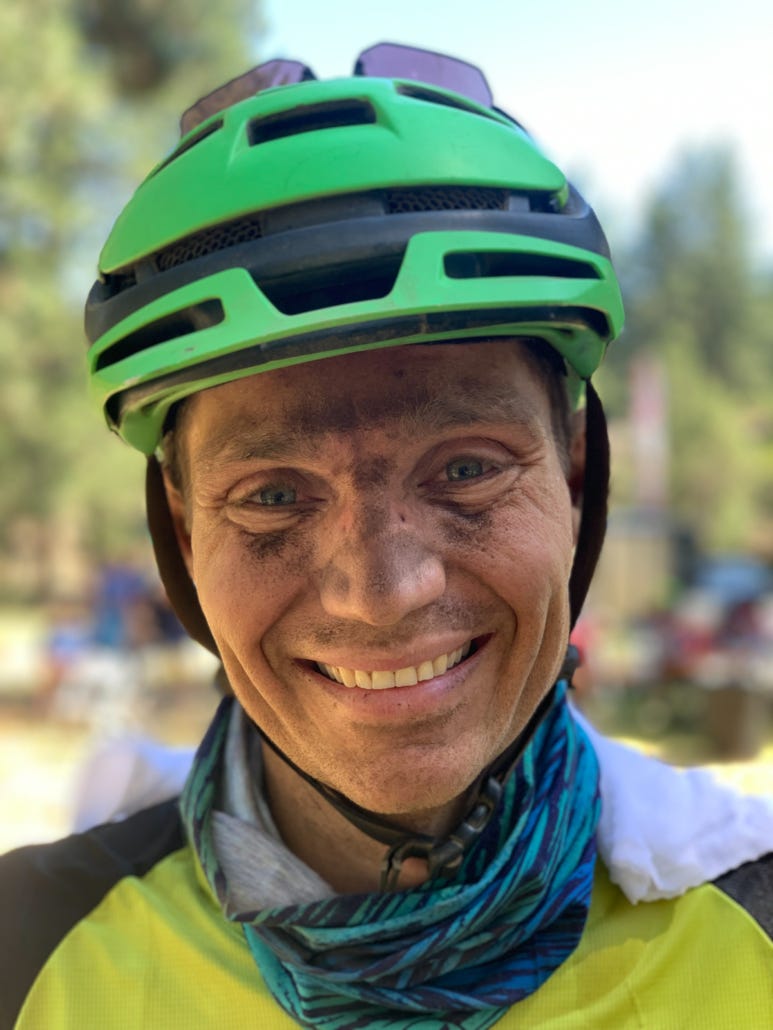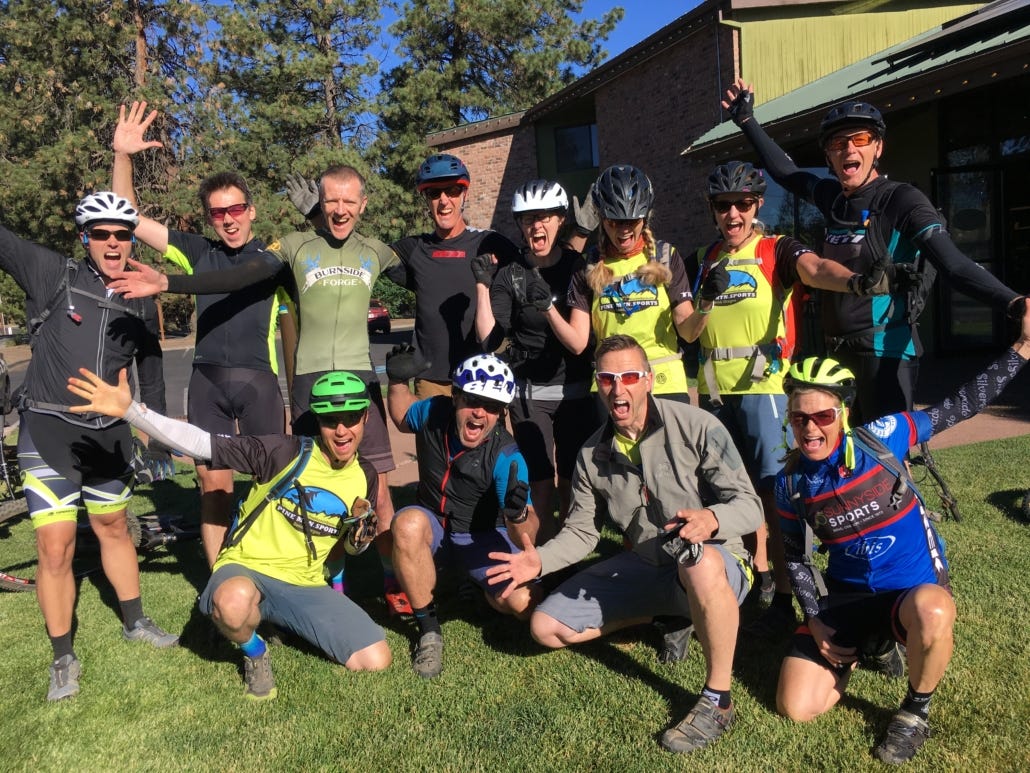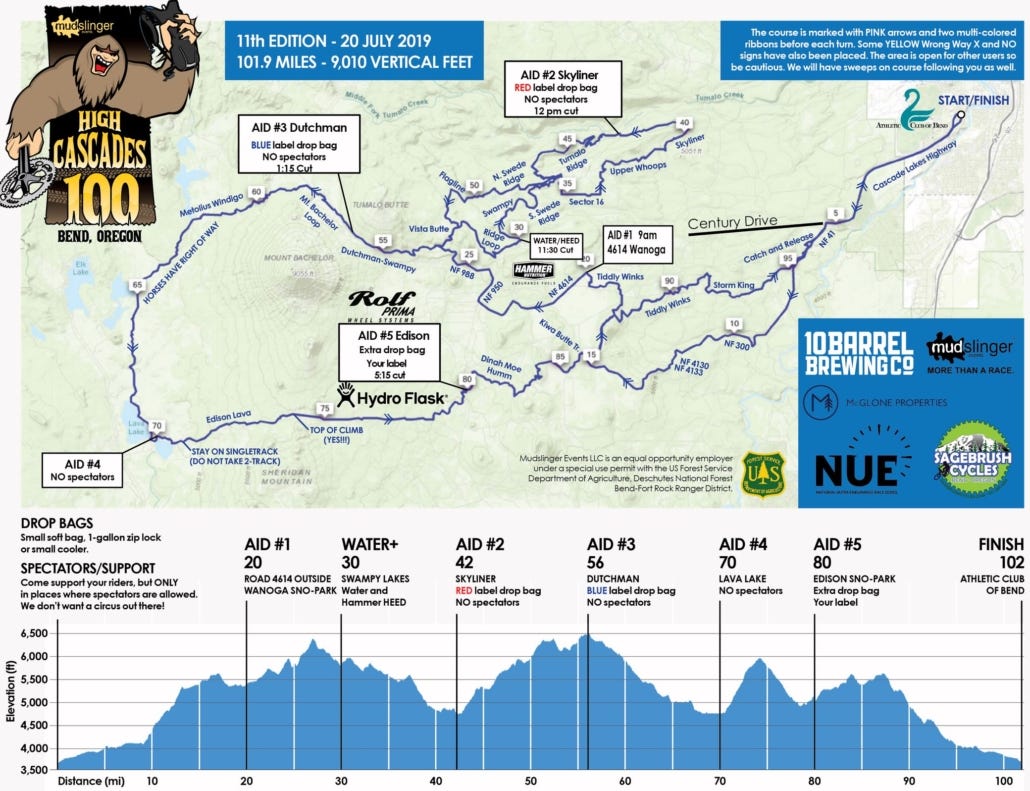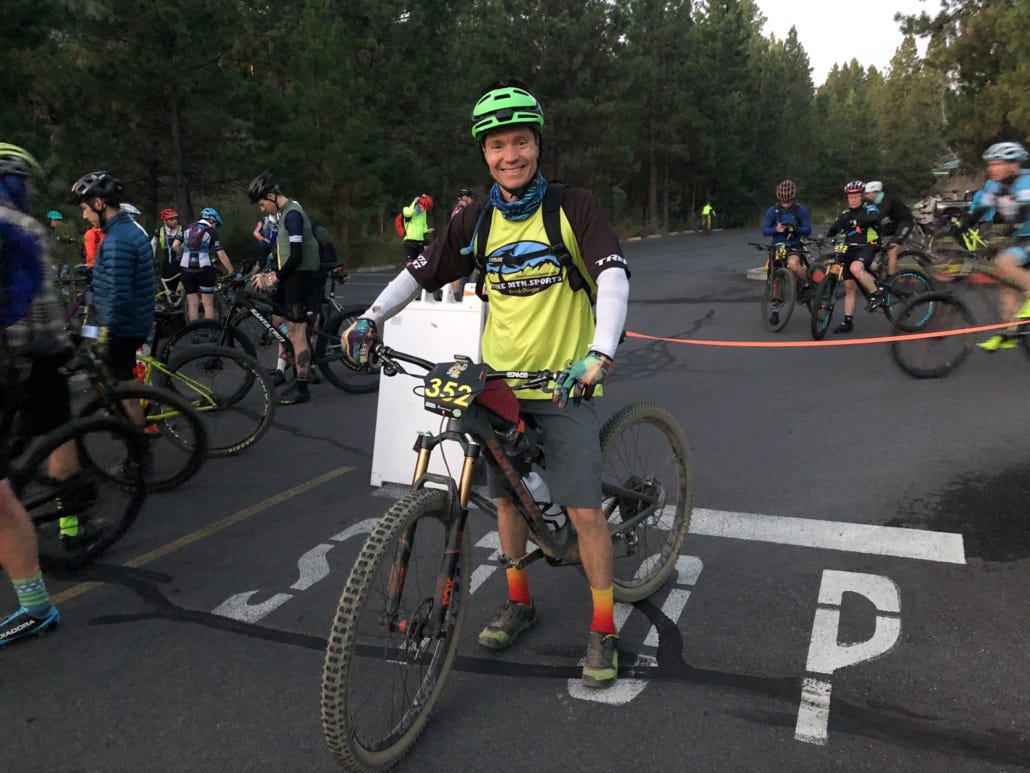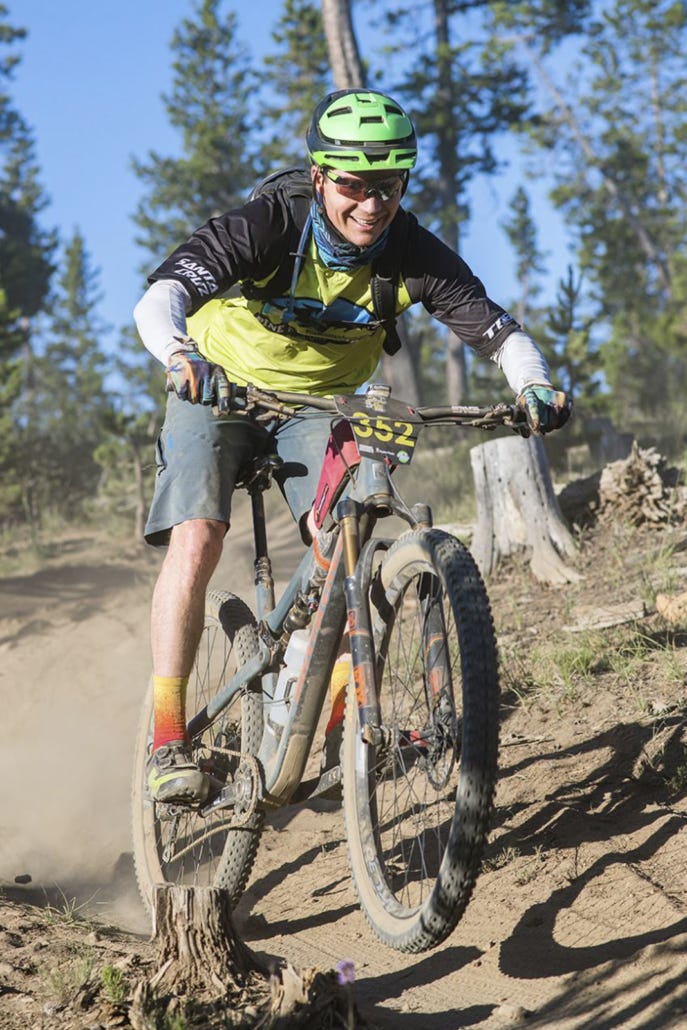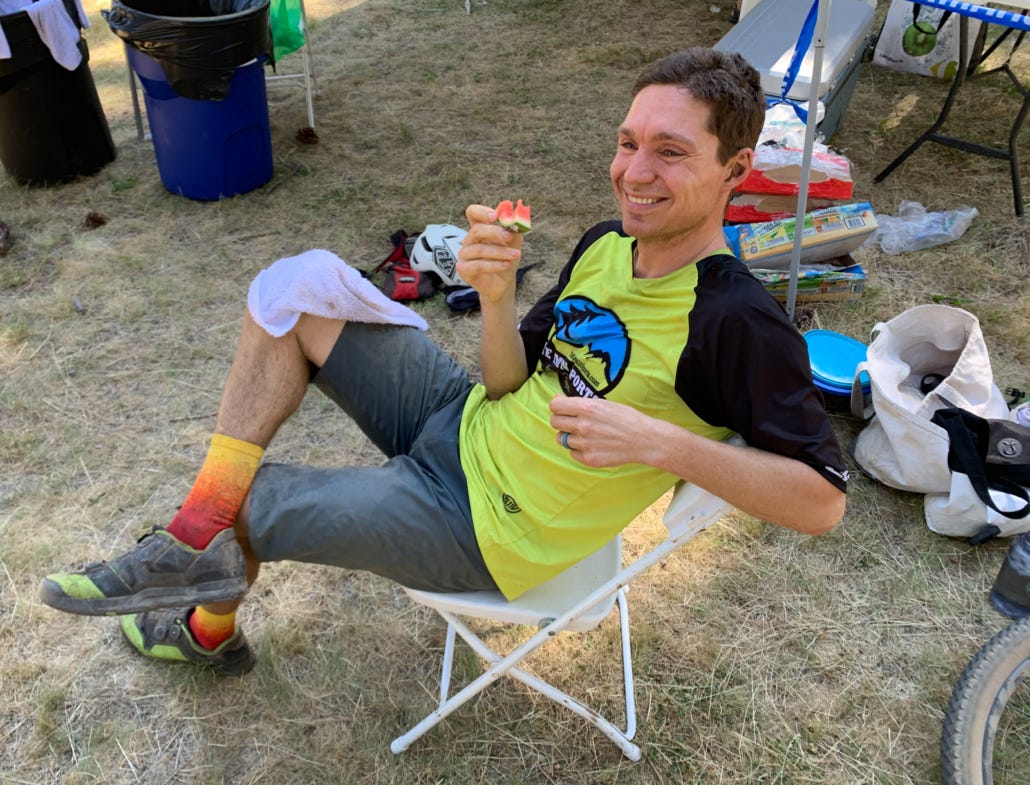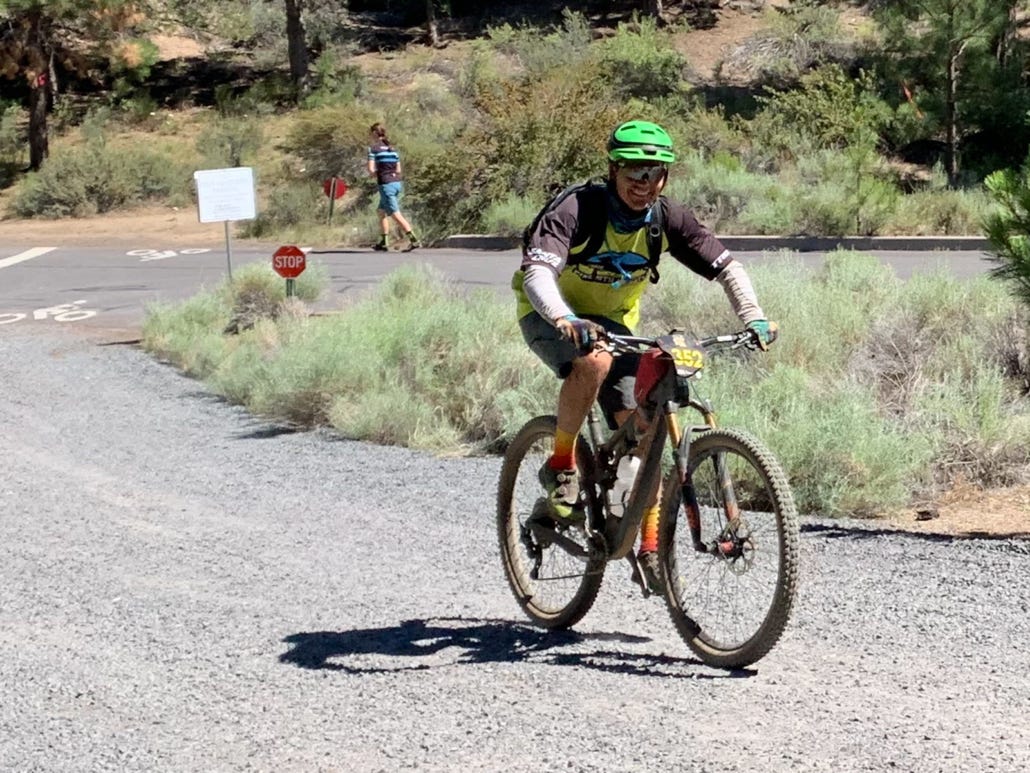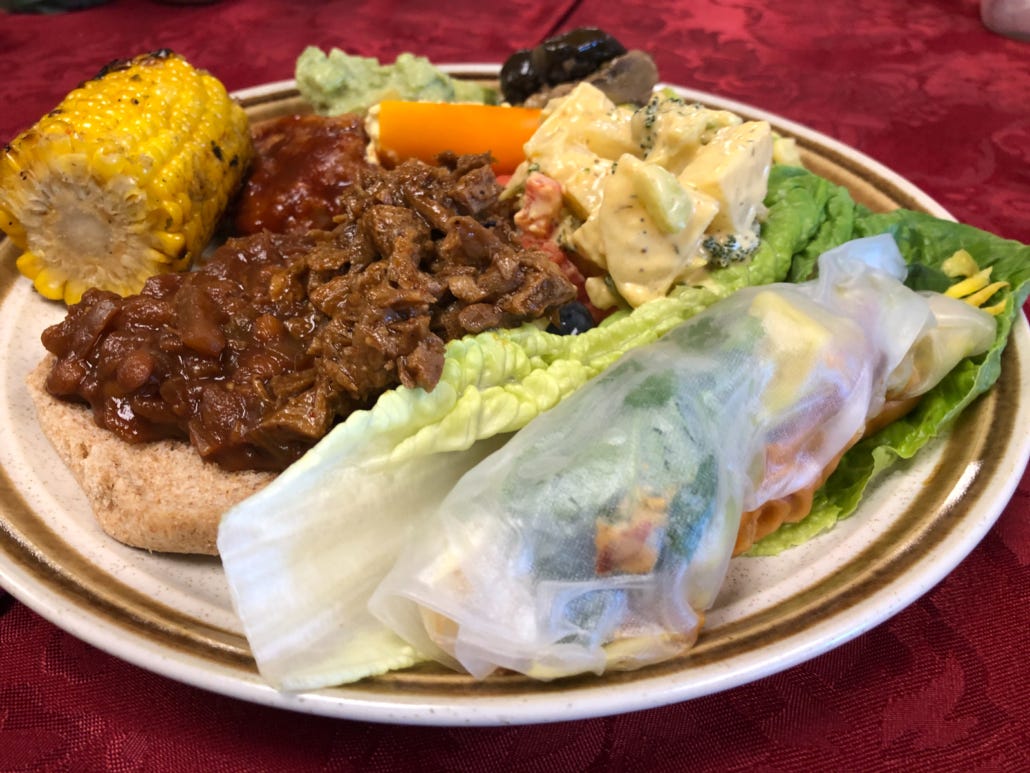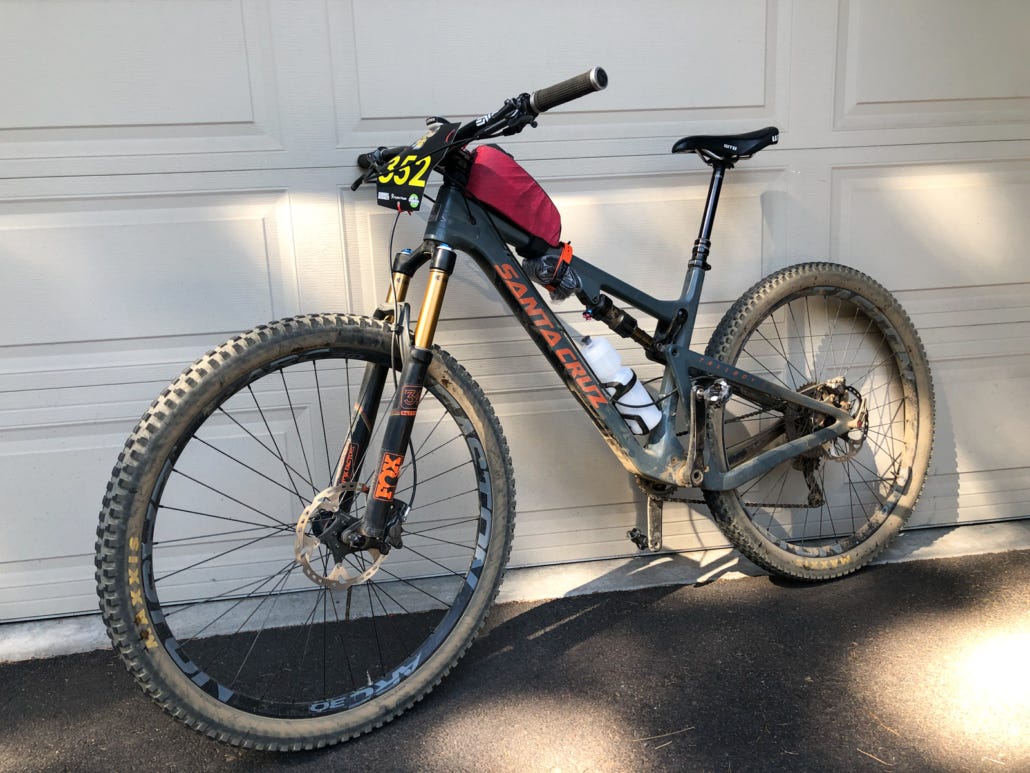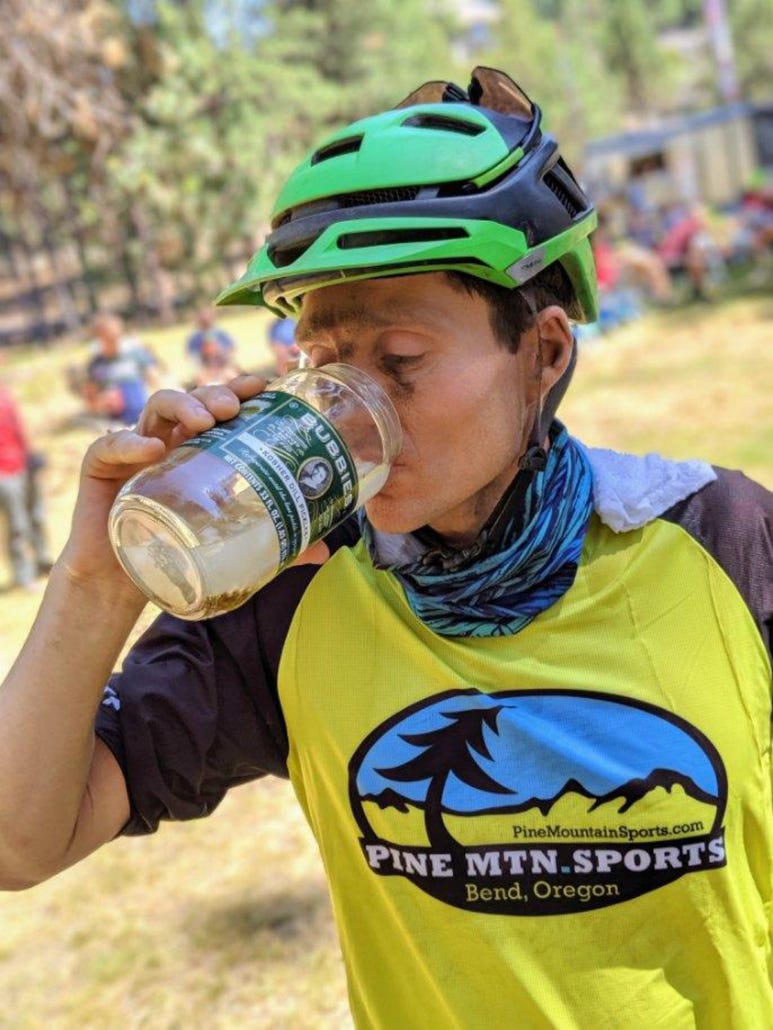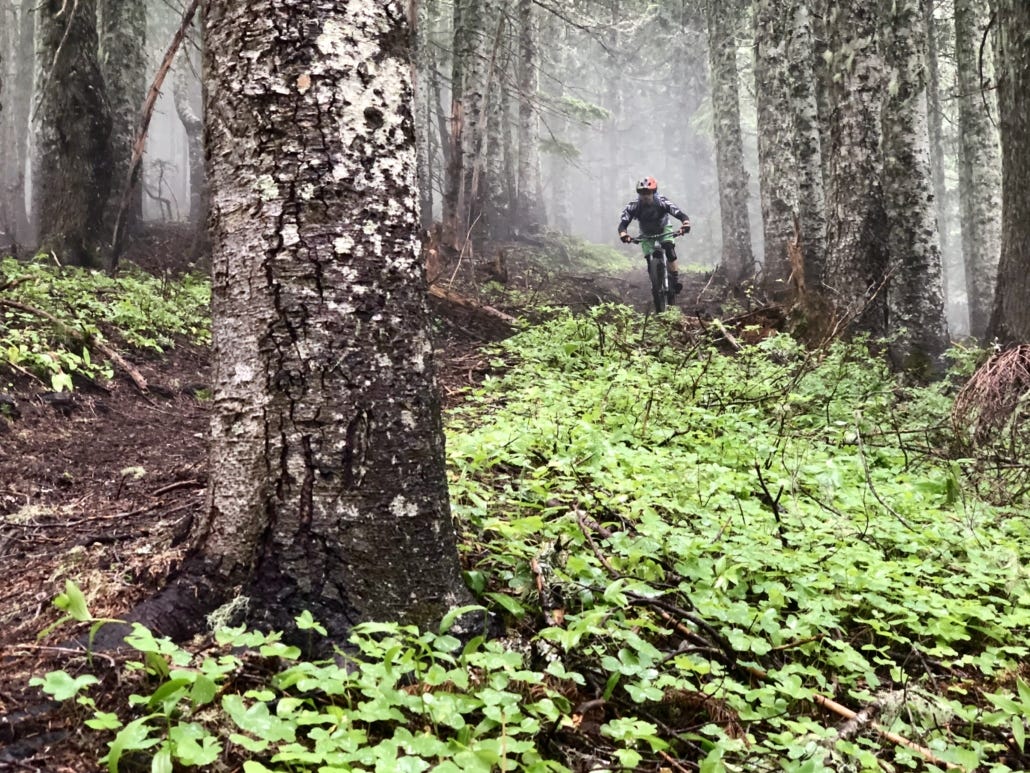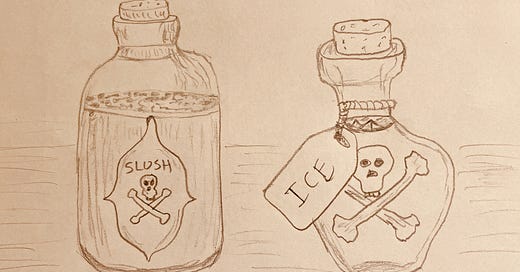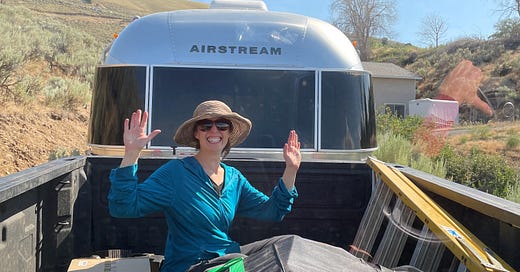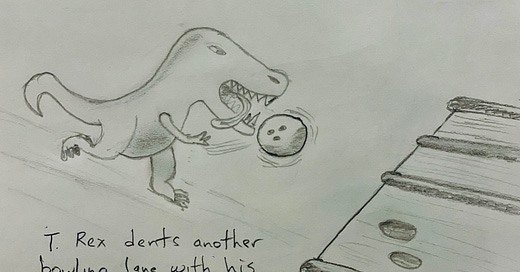
Racing the High Cascades 100, Round Two
The ride summary of a fellow racer in the High Cascades 100 mtb race were two sentences not often found together: “Fun day. GI issues for 20 miles, plus 2 code browns.”
Riiiight. Fighting a lurching stomach while pooping yourself twice is everyone’s idea of a fun day! Perhaps only for types with screws loose enough to race 100 miles on a mountain bike?
Clearly I’m one of them. At least I wasn’t the racer with the code browns!
High Cascades 100 Race Report, Round Two
I raced the High Cascades 100 in 2017 to explore Bend’s trail network during training and test myself against an intimidating distance. Before that year, I’d never ridden more than 50 miles straight on a mountain bike.
For my second High Cascades 100 attempt in 2019, I scored a free entry a week before the race. Compared to my previous structured efforts, my training plan was a bit different. By which I mean…uhhh, I didn’t have one. Hey, it’s only 9-10 hours of riding, so what could go wrong?
Training For The Race
Don’t let me mislead you. I wasn’t off the couch given that Chelsea and I had bike toured through Spain and Portugal that spring. As an ambassador for Pine Mountain Sports in Bend, I also led a HC100 training series in June and July. Those were 40, 55, and 70 mile rides at a “non-conversational” pace (about 10 mph average).
That first 40-miler in June didn’t go well. I’d traveled for 30 hours from Europe the day before and was jet lagged, dehydrated and unprepared for the powerful bursts of energy that mountain biking requires. Thirty miles in, both my quads felt like a viper’s fangs were buried in them every time I got out of the saddle.
I survived (without antivenom) and did regular rides into July. For the final 70 mile ambassador ride, we all pushed hard and I finished feeling great.
Hang on. The race is going around Mt. Bachelor this year, you say? What’s that, a free entry is available?
Count me in.
My Results
Let’s start with the numbers (here are the details on Strava)
Total Mileage: 101.2
Race time: 9:27 hours (pace of ~10.5 mph)
Total vertical gain: 9,974 feet
Finishing place out of 388 riders: 40th (better by 25 places versus my 2017 time)
Hours behind the winners: over 1.5. HOW DO THEY GO SO FAST?!
By the way, dig these kinds of posts? Sign up for the free 2x/month Traipsing About newsletter for more tales from the mountains and creative challenges like drawing and piano when I'm off the bike.
Race Report/Memorable Moments:
Morning: I wake up at 4:45 and eat my standard breakfast, oatmeal with fruit. I pedal to the starting line in the dark.
Mile Zero: I’m less nervous this time around compared to 2017. I’m confident 100 miles is doable. Still, the energy is palpable and I’m fired up. The starting line song “How You Like Me Now?” by The Heavy will be stuck in my head all.freaking.day.
Mile 9: As planned, I hang with the front peloton through the road section to the climb at Tyler’s, chatting with various people that I recognize. It’s striking how connected I feel to the Bend community compared to 2017.
Last time, my mantra was “slow on the uphill, steady on the flats, free speed on the downhill.” This year, I’m planning to be on the gas more, riding that anaerobic threshold.
Mile 17: the first singletrack descent features Spandex-clad racers exploding in horror at the sight of any rocks. My chance to make up time! Next is a fire road past Wanoga Sno-Park, then back up the sandy hell pit along the highway to Mt. Bachelor. A woman on a single speed (!) is haaaammering up the fire road. I’ll catch her on the steeper climbs when she runs out of gears, but sheesh, she’s strong.
Back on singletrack for the climb and descent down to Swampy Sno-Park. I’m feeling good and pushing hard. I roll into Swampy at mile 30, ready to switch out my hydration pack and grab food from Chelsea…wait, where is she? WHOOPS, I'm ahead of schedule. (She arrives shortly after, phew.)
Rookie move, D! Two minutes lost. So much for my chances of winning HAAA.
Next up is a fun section of singletrack down to Skyliner Snopark…sayonara to the morning climbing as I head downhill. I know these trails cold and it’s a pleasure ripping along in the morning light. Long races are taxing due to maintaining focus, but I rarely find my mind drifting or feeling emotionally exhausted from any big mountain bike ride.
Mile 42: Back on the climb train. I continue to stay on the gas and feel great up Tumalo Ridge. I’m playing cat and mouse with the same riders as we yo-yo along. Fun fact about 100 mile races: chatting with people as you race isn't that uncommon.
Mile 57: Aid station at Mt. Bachelor! Cheery volunteers hand me my food drop bag. Unfortunately, other than delicious, salty pickles (SO GOOD), I’m not feeling that hungry during this race and don’t feel like eating my PBJ wrap (<--foreshadowing). Pushing one’s athletic limits pulls blood from the stomach to extremities, which is why so many endurance athletes experience GI and stomach distress during races. As if the exercise isn’t hard enough?
Mile 57-71: Ohhh man, the downhill part around the backside of Bachelor is a blast. It’s a loose, fast jaunt, especially tailing a fast rider from Colorado. The hard effort means I don’t get a chance to eat anything (risk of dying from crashing outweighs my hunger) or drink much. That’s fine though, it’s not like the climb up Edison Lava is hard af, riiiight?
Mile 73: Poor fueling catches up with me. My legs weigh 1,200 pounds and I’m walking my bike. (So are others.) Sections of Edison are steep, rocky and sandy face punches after eight hours of pedaling. Smiles are…infrequent.
This energy lag isn’t fitness, it’s a fueling issue. After the race, I total my calories and I only ate 2,400. That’s about 1,400 lower than planned given my goal of 400 per hour.
I gut my way through it, walking a bit and stuffing Shotbloks down my gullet. I start to feel better, but sure get sick of sugary carbs during these long rides. If only pickles sported substantial calories!
Mile 80: Chelsea and our friend Jules jump up and down in the aid station. Jules, a recent arrival from New Jersey’s suburbs, is wide-eyed watching the crazed, spittle-covered riders coming through. I eat a few bites of PBJ wrap, crunch a pickle (delicious again) and swap my hydration pack.
My energy levels are still lagging thanks to not eating. I dog it for another 10 minutes and a couple riders pass me (nooo) before I pull out of my torpor. Not like it matters where I place since I’m not contending for the podium, but…you know, competitive spirit!
By the time I hit the top of Tyler’s Traverse again, I’m ready to go. From there, it’s a hard push on singletrack for miles (Tiddlywinks, Stormking, Catch and Release). For the last highway section, three of us form a pace line and hammer it home on Cascades Lake Highway. We’re doing 25 mph on and my legs smolder, then burst into fiery pillars of torched muscle from the effort.
They drop me with a mile to go and I roll into the finish line solo but grinning, 40th overall. Nothing to write home about, but 25 places better than my first High Cascades 100 and this time with no structured training. I’ll take it.
I’m not tapped out though, which is better than I expected at mile 80. At the finish line, I chug (you guessed it) pickle juice, eat a little food and congratulate other riders.
Then I pedal home to sit in a bathtub full of ice, a delightful tradition for me after crusher rides. I round out the day with our monthly vegan potluck, where those behind me in line are left with empty plates in the wake of me eating all the food.
All the Details
Yes, I took training and preparation for this race less seriously than my first High Cascades 100. However, a couple years of (relatively) long-distance mountain biking prepped me for success (i.e. not collapsing on the trail or crapping in my chamois). #winning
Here are my takeaways and lessons learned from my second time racing the High Cascades 100..
My Racing Technique:
To avoid choking dust and crowded trails, stick with the front peloton until it hits dirt. For the HC100, that’s nine miles of road to Tyler’s Traverse (same every year to break up the crowd).
Steady pace for climbs, but push harder early on relative to 2017.
Push the descents to make up time vs people riding hardtails who crush me uphill. Impossible to make up the difference given how XC-oriented High Cascades is. Or maybe I'm just slow.
Not be afraid to pass on downhills. “Pass when you’re good, please” was my go-to phrase. Other riders were polite and accommodating.
Eat food and drink water consistently. I did the latter well, but not eating much from miles 40-70 put me in a fueling hole by mile 75 that hurt.
Stop as little as possible. I ended up at six minutes total split between mile 40, mile 56, and mile 80, even with the mishap with Chelsea arriving late to the first refueling.
My Training
Most people don’t ride a full 100 miles preparing for a race and neither did I. My longest ride was 7 hours and my maximum distance was 70 miles.
Rather than lots of back-to-back long rides, this year I just rode for fun when I felt like it. Here’s a general sense of my prep:
Bike touring in April/May on a heavy AF bike through Spain and Portugal. Base training!
This time around, I skipped all the back-to-back 3-5 hour days. However, I still think that’s the best approach for being ready physically and mentally for such a long day. I’ve logged plenty of long rides since 2017’s High Cascades 100, including ~50 miles/day for two weeks straight bikepacking the Oregon Timber Trail. I was confident my accumulated fitness would carry me along.
Unlike some riders, I don’t ride bike trainers or aim for heart rate zones or power thresholds. Yes, I would be faster if I did this. However, I hate it. (As I like to joke, I’d rather be slow than ride inside.) If you’re trying to podium or win an age group in a well-known race like HC100, I think it’s almost mandatory to train like that though.
For fitness-building threshold efforts, I simply ride uphill climbs hard for 10-30 minutes. No data, just by feel.
My mileage pre-race wasn’t anything crazy. In talking to other riders, it seems like 10-15 hours a week is fine for a comfortable performance.
My Food
I aim for max carbs. Your body won’t process any fat/protein that you eat during the race, so only consume those if it helps you down carbs. For me, that’s a little peanut butter in a tortilla/jelly/banana wrap.
Split carbs 50/50 fructose and glucose. We can only process a certain amount of each before uptake stops, so balance it for maximum crushing.
What I Ate
Shotbloks, about 2-4 blocks per hour
Medjool dates
Picky Bars (not 100% carbs, but they go down easily for me).
Pickles. Zero calories, but all the happiness and salt.
PBJ wraps with raisins and bananas. Not much peanut butter.
Hydration
Same as my first HC100, I decided to a) maximize water access and b) minimize transition times. To accomplish this, I used two hydration packs that Chelsea cycled out and handed to me at the aid stations all refilled and ready to rumble. I also carried a water bottle with water, salt, and lemon water.
I used 50 oz. of water in each pack plus Skratch Labs electrolytes. The secret weapon: I made Skatch ice cubes and put those in the water on race day. Not only was cold water delicious, the ice cubes don’t dilute the electrolyte mix.
My goal was simply to drink water, and lots of it. For a race with so much singletrack, the hydration packs made it possible for me to drink basically whenever, as opposed to only on smooth trails or fireroad. My approach worked well for a second time and I’d recommend it!
Note to people trying to crush it: some kind of carb formula (Hammer, etc) mixed into water is the elixir pros dominate with. Sugar lets you buzz like a hummingbird at max sustainable output!
Lessons learned:
Give my aid station helpers a bigger buffer zone in case I’m ahead of schedule.
Eat consistently, even if it means slowing down or quickly stopping. The time gained from full energy supplies easily makes up for this. Plus bonking in a race sucks!
For the second time, my Santa Cruz Tallboy was the perfect bike for this race. My gear list was almost identical to last time; check it out in my original post.
A dust guard or mask is worth using until the 40 mile aid station. (Gawd, do we have to wear these forever?! F off, COVID.) I used a neck gaiter and it saved my lungs. I didn’t need it after the pack split up at mile 40.
Overall, I enjoyed the heck out of round two of the High Cascades 100. Mike Ripley from Mudslinger Events puts on a fantastic event, other riders are respectful and awesome, and I highly recommend checking out the race in coming years. Who knows, could even happen this July.
Ride on!

